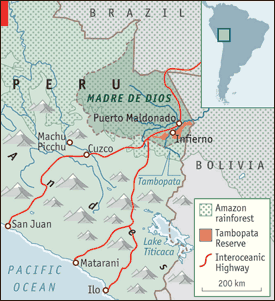Ecotourism in Peru
Rumble in the jungle
April 10, 2008 -The Economist.com
From The Economist print edition
How barefaced capitalism can help save the Amazonian rainforest
PUERTO MALDONADO -- FROM the top of the 30m-tall viewing platform at Posada Amazonas, a thatched 30-bed tourist lodge in the Peruvian Amazon, immense trees -- some more than a millennium in age -- extend to the horizon. It seems an untroubled Eden. But below the canopy, danger lurks in the shape of a new paved highway.

Peru's Madre de Dios region has been undergoing an ecotourism boom. More than 70 "eco-lodges" cater to tourists from around the world, eager to experience a few days in the Amazon. Last year more than 60,000 foreigners visited the area, a 20-fold increase over 15 years.
Its success stems from two factors. First, the region comprises vast areas of pristine rainforest, including some of the most biodiverse places on earth, much of it protected (at least on paper) in magnificent national parks. It is also easily accessible. Its capital, Puerto Maldonado, is less than an hour's flight from Cuzco, gateway to Machu Picchu, the Incas' ruined city. From Puerto Maldonado, many of the lodges are just an hour or two away by riverboat.
Rainforest Expeditions, the company that runs Posada Amazonas, is the biggest tourism operator in the region, hosting a quarter of the tourist nights spent there. Founded in 1989, its goal was, and still is, to use tourism to foster conservation.
Posada Amazonas sits above a bend in the Tambopata River, on 2,000 hectares (5,000 acres) owned by the 148-family community of Infierno. In 1996 Rainforest Expeditions entered into a 20-year joint venture with the community, most of whom are indigenous Ese-éja people. Under it, they share the decision-making through an elected "control committee" and receive 60% of the profits -- totalling $130,000 last year. They also got most of last year's $140,000 payroll. The company is now training them so that they can take over the whole operation in 2016.
The arrangement is already paying rich dividends: Infierno's literacy, nutrition and healthcare levels have all greatly improved, while the surrounding forest remains unspoiled. "We have stopped hunting so much," Carlos Dejavijo, a control-committee member, says: "We are thinking more about the future."
Because Rainforest Expeditions is a for-profit venture, says Eduardo Nycander, one of its founders, it has been able to undertake conservation and social development more nimbly than governments or NGOs. "By protecting my interests," he explains, "I am helping conservation. I'm not Father government, nor Mother NGO -- I am here to make money."
So far, Mr Nycander has applied his approach to a few thousand hectares. Now he has a chance to try it on a regional scale. Just 15km (9 miles) from Posada Amazonas, crews are at work improving the dirt track known as the Interoceanic Highway. By 2010, when the last 700km have been paved, it will form the first all-weather link between Brazil and Peru's Pacific coast, cutting the three-day trip from the Andes to the Brazilian border by two-thirds.
But roads in the Amazon are notorious for provoking waves of development and uncontrolled deforestation through logging, mining and agriculture. In Brazil, a halo of deforestation typically extends 50km on either side of a road within a decade of paving. Recent studies by Leonardo Fleck, an economist, have shown that the scale of destruction can result in a net economic drain, in spite of the infrastructure investment -- expected in the Interoceanic Highway's case to reach around $1 billion. This is especially worrisome in Madre de Dios because the road cuts between the two biggest protected rainforest areas, and substantial sections of seven more protected areas lie within 50km of it.
Though Peru has wide-ranging environmental laws, they are little-applied and unfunded. Mr Nycander points to Peru's government as the main problem. Earlier this year it sought to award petroleum concessions inside the Tambopata Reserve behind Infierno. So conservationists and ecotourism operators in Madre de Dios are now scrambling to head off uncontrolled development on their own.
By promoting tourism, Mr Nycander hopes to create a big constituency wanting to keep the forest standing. In co-ordination with Odebrecht, the Brazilian company doing the roadwork, he hopes to establish an ecotourism corridor along the road. He believes that the preservation of a strategic swathe of 150,000 hectares involving a series of parks, private reserves, indigenous lands, ecotourism and conservation concessions, brazil-nut and other extractive permits -- as the basis for an economy that depends on healthy rainforest -- would do the trick.
Already land prices near the road are climbing, thanks to speculation in the face of high soya and corn prices. With the monetisation of ecosystem services like carbon storage still largely theoretical, ecotourism is one of the few non-destructive land uses capable of generating an immediate, competitive cashflow.
Kurt Holle, the co-founder of Rainforest Expeditions, reckons the company's scale is just big enough to secure the Tambopata Reserve and the much bigger national park behind it. But he cautions that the regionwide picture is uncertain: "It's like the front of the battle," he says. "If the trenches -- the ecotourism operations -- are overrun, the reserves could be plundered."